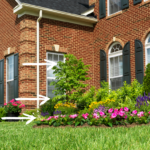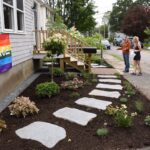Small house landscaping can play a crucial role in enhancing the overall appearance of a home, regardless of its size. With limited space to work with, it is important to maximize every inch of your outdoor area to create a beautiful and functional landscape. Here are some tips to help you make the most of your small house landscaping.
When dealing with a small outdoor space, it is essential to carefully plan the layout of your landscaping. Consider the size and shape of your yard, as well as any existing features such as fences, walls, and trees. Utilize vertical space by incorporating hanging plants, tall potted plants, or trellises to add depth and interest to your landscape. By carefully strategizing the placement of plants, pathways, and outdoor furniture, you can create a visually appealing and functional outdoor space.
Another important factor to consider when landscaping a small house is the selection of plants. Opt for plants that are well-suited to the size of your yard, such as dwarf trees, compact shrubs, and low-growing ground covers. Choose plants that offer year-round interest, such as evergreen shrubs or perennials that bloom at different times of the year. Incorporate a variety of textures, colors, and heights to create a dynamic and visually appealing landscape.
Incorporating hardscape elements into your small house landscaping can also help maximize your outdoor space. Create a focal point, such as a small patio, seating area, or water feature, to draw the eye and create a sense of depth in your yard. Use materials that complement the style of your home, such as stone, brick, or wood, and consider adding lighting to enhance the ambiance of your outdoor space in the evening.
One way to make a small outdoor space feel larger is to create defined zones within your landscape. Use pathways, borders, or plantings to create separate areas for dining, lounging, gardening, or entertaining. By dividing your yard into distinct spaces, you can create a sense of expansiveness and functionality in a small area. Consider using modular furniture, foldable or stackable seating, and multipurpose accessories to maximize the usability of each zone.
Water conservation is an important consideration when landscaping a small house, especially in regions with limited water resources. Choose plants that are drought-tolerant and require minimal watering, such as native species or succulents. Consider installing a rain barrel or drip irrigation system to water your plants efficiently and reduce water waste. Mulch your garden beds to retain moisture and suppress weeds, and consider incorporating permeable paving or gravel pathways to reduce runoff and promote water infiltration.
In conclusion, landscaping a small house can be a challenging but rewarding endeavor. By carefully planning the layout, selecting appropriate plants, incorporating hardscape elements, creating distinct zones, and conserving water, you can create a beautiful and functional outdoor space that complements your home. With a little creativity and strategic design, you can transform your small outdoor area into a welcoming retreat that enhances the overall appeal of your home.
















